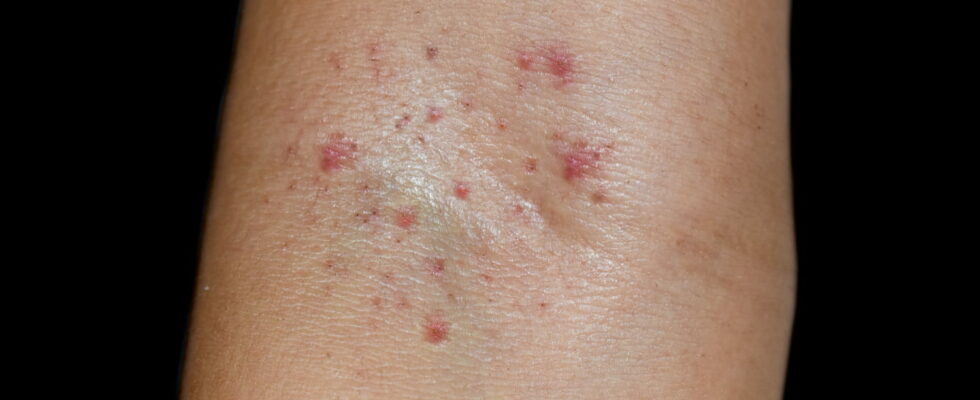Petechiae are small red or purple spots (or dots) on the skin of the face or body that are not itchy. Pregnancy or purpura are among the causes of these micro-hematomas. How to get rid of it? Explanations and advice from Dr. Jean-Luc Rigon, dermatologist and venerologist.
Of the small non-itchy red or purple colored spots can appear on the skin of arms, legs or face. They are called petechiae. They can be linked to a purpura and are favored by pregnancy (among other causes). It’s what petechiae? For what do they appear? How recognize them ? When to worry ? How don’t care rid ?
Definition: what are petechiae?
Petechiae are small dot-shaped spotsusually from purplish red color, which are visible on the skin and do not blanch under pressure. They are consecutive to a microhaemorrhage related to the rupture of a blood capillary (small subcutaneous vessel). Petechiae appear most often on the skin (especially on the limbs: legs, arms) or more rarely on the oral mucous membranes (tongue). “Usually these are micro-hematomas that appear where the blood weighs the most“, summarizes Dr. Jean-Luc Rigon, dermatologist.
Why do petechiae appear?
The petechiae are suggestive of a purpura, a generic term that includes these dermatological lesions. Often of benign origin, they can be due to a small local physical trauma. Coughing, vomiting and sobbing can also cause harmless petechiae on the face, especially around the eyes. “Small vessels burst around the eyes, it is generally not serious, but one must be vigilant to be wary of an association with a microhaemorrhage of the retina“says Dr. Rigon. If symptoms persist, consult. “Approaching menstruationwomen may also have some petechiae on the skin“, adds Dr. Rigon. People with venous insufficiency are also more at risk of having petechiae, induced by poor blood circulation. There pregnancy is also a risky period. Petechiae can be the sign of thrombocytopenia (abnormally low level of thrombocytes (platelets) in the blood): small hemorrhages in the form of petechiae or purpura may appear on the skin. Again, petechiae are painless and often go away naturally. If they do not fade, it is better to consult a doctor. Finally, older people are more prone to have petechiae, especially on the forearms and hands. “When you get older, the layer of fat under the skin reduces, the softness disappears, the vessels are more prone to ruptures during minimal trauma“, explains Dr. Jean-Luc Rigon.
What are the symptoms of petechiae?
The petechiae resulting no pain or itching, they only manifest themselves through their particular visual aspect. They are mainly located on the legsbut they can appear on all areas of the body such as the face where the mucous membranes (tongue, soft palate…). They are bright red in color, verging on purple, and generally measure between 1 and 4 mm in diameter. As the days go by, they evolve like bruisesbecoming yellow, before disappearing.
Red spots on the skin: when to worry?
If they occur in a child with a fever and they spread rapidly, an emergency consultation is essential, because it can be a sign of purpura fulminans, a serious infection that affects children and adolescents more frequently, especially during certain menigitis.
How to recognize petechiae?
The diagnosis of petechiae is often clear from the clinical examination, Above all, one of the characteristics of petechiae is not to disappear at the maneuver called vitropression, that is, when pressure is exerted on the skin. Unlike other skin lesions, petechiae do not disappear, indicating that red blood cells have come out of blood vessels.
How to get rid of petechiae?
It is not no need to treat petechiae, these usually go away on their own within a few days. If petechiae are suspected in connection with a purpura fulminans, emergency treatment must be carried out. Of the antibiotics will be administered without delay, and a transfer in hospital under medical supervision is essential. When this cause is not retained after the various examinations, another cause of appearance of these petechiae will be sought and treated specifically.
Thanks to Dr Jean-Luc Rigon, dermatologist venerologist in Nancy (Meurthe-et-Moselle), for his details.
